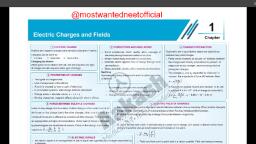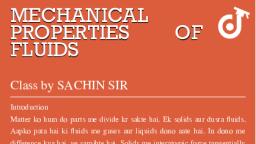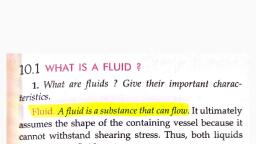Page 1 :
Chapter 10, Mechanical Properties, of Fluids, Chapter Contents, Introduction, Introduction, A substance that can flow is called fluid. Thus, both liquids and gases, are fluids. They have no definite shape, but take the shape of the, Pressure, Streamline Flow, vessel that contains them., Bernoulli's Principle, Some important characteristics of fluids are, They have a very small shearing stress ie., A little application of, force along the tangents to their surfaces, brings them in motion, along the force. So they start flowing along the direction of the, force applied., Viscosity, • Surface Tension, • Some Important Definitions, Gases are highly compressible, but for liquids the external pressure, causes a very small change in their volumes. Liquids have free, surface of their own while gases have not., Formulae Chart, Quick Recap, This chapter deals with the study of important properties and, bchaviour of fluids like fluid pressure, viscosity, surface tension, turbulence etc., PRESSURE, It is a common observation that it is easier to cut vegetables with a sharp, knife than with a blunt one. It is because a blunt knife has a wider surface, area that comes in contact with the vegetables than that in case of a sharp, knife. The excess area of contact decreases the impact of force. This brings, in picture, the concept of pressure. We say that a sharp knife can exert more, pressure than a blunt knife for the same force applied on the vegetable., We can define pressure as the normal force acting per unit area of a surface, i.e., P =, A, For an object lying on a surface, the force pressing on the surface is the, weight of the object. But in different orientations it might have a different area, in contact with the surface and therefore exert a different pressure (see the, following figure)., Aakash Educational Services Pvt. Ltd.-Regd. Office: Aakash Tower, 8, Pusa Road, New Delhi-110005 Ph.011-47623456, Scanned by CamScanner
Page 2 :
Board & Competitive Exams., 120 Mechanical Properties of Fluids, 100 N, 100 N, 5 m, 10 m, 10 m, 1 m, 5 m, A= 50 m, F = 100 N, P=2 N/m?, A= 5 m, F = 100 N, P= 20 N/m, 1 m, We observe that the same force (weight) exerts different pressures for different areas in contact. Lesser the, area, more is the pressure exerted for a given force., This discussion of pressure can be extended to the fluids. When we immerse an object in a fluid, which is, at rest, the fluid exerts a force on the surface of the object. This force always acts normal to the surface., It is so because, if there were any component of this force parallel to the surface of the object, then according, to Newton's third law, the surface will also exert a force on fluid in opposite direction parallel to it. This will, cause the fluid to flow parallel to the surface. But this never happens practically. The fluid remains at rest., Hence, the force exerted by fluid on the object is always normal to its surface. This normal force acting per, unit area around a point is called the pressure at that point., Measurement of Fluid Pressure, Fluid pressure can be measured by a device that consists of a spring fixed across an evacuated glass chamber, as shown in the figure below. One end of the spring is fixed at the bottom while the other is connected to a, movable piston at the top. The spring is calibrated to give the measure of force exerted on the piston., Vacuum+, As we submerge this device in a fluid, let the fluid exert a normal force F on the piston. Due to this, the, piston moves down till it is balanced by the upward restoring force of the spring. The calibration on the spring, gives the measure of this force. Let it be F. If the area of the piston is A, then the average pressure exerted, by the fluid on the piston can be given as, F, Pay =, A, AF, If the area of the piston is made very small, then pressure is given as P = lim, AA 0 AA, Pressure is a scalar quantity since AF that appears in the numerator, is the normal component of the force, and is not the force vector. Its Sl unit is N m-2 and the dimensions are [ML-T-21. N m-2 is also called pascal, (Pa) in honour of the scientist Blaise Pascal., Air around us is also a fluid. Hence, it also exerts pressure on us. It is known as atmospheric pressure. The, common unit used to measure atmospheric pressure is "atmosphere", denoted as "atm". The atmospheric, pressure at a point is numerically equal to the weight of a column of air of unit cross section extending from, that point to the top of the atmosphere. At sea level, the atmospheric pressure is 1 atm = 1.013 x 105 Pa., Aakash Educational Services Pvt. Ltd.-Regd. Office: Aakash Tower, 8, Pusa Road, New Delhi-110005 Ph.011-47623456, Scanned by CamScanner, e00000000
Page 3 :
Board & Competitive Exams., Mechanical Properties of Fluids 121, Practical Applications of the Concept of Pressure, 1., Pins and nails are made to have pointed ends., When a force is applied over the head of a pin or a nail, it transmits a large pressure at its tip and hence, easily penetrate into the wall., A sharp needle (syringe of an injection) can easily penetrate the skin, but a wider object like a ruler, can't do so when pressed against the skin with the same force., 2., 3., It is difficult for a man to walk on sand while a camel can walk easily on it, inspite of the fact that a, camel is much heavier than a man. This is because camel's feet have a larger area than the feet of a, man. Due to larger area, the pressure is less., Example 1: Find the pressure exerted at the tip of a board pin, of area 0.1 mm?, if it is pressed against the, board with a force 15 N., Solution :, Normal force applied on the pin, F = 15 N, Area of the tip of the board pin, A = 0.1 mm2, = 0.1 x 10-6 m?, 15, Pressure, P =, A, Nm2, 0.1x106, = 15 x 107 N m-2, Example 2:, A room has floor dimensions of 4.0 m x 5.0 m and height of 3.0 m., (a), Find the weight of the air in the room at 20°C, (b), What is the weight of an equal volume of water?, (c), What is the total downward force on the floor surface due to air pressure of 1.0 atm?, Solution :, The densities of air and water., (a) The volume of air in the room = (4.0 m) (5.0 m) (3.0 m), = 60 m3, The mass of the air is mar = Pair Vair = (1.2 kg - m-3) (60 m3), = 72 kg, The weight of the air is Wair= mg = (72 kg) (9.8 ms-2), = 705.6 N, (b), The weight of water = mwater g =, Pwater, •V., water 9, = (103 kg · m) (60 m3) (9.8 ms-2) 5.9 x 105 N, (c) The downward force on the floor surface is, F = (Air pressure) (surface area), = (1.013 x 105 Nm-2) (4.0 m x 5.0 m) = 2.0 x 10° N, Note : The above force has large magnitude. This force is enough to collapse the floor. Why, does it not collapse? It is due to the upward force on the underside of the floor. If we neglect, the thickness of the floor, this upward force is exactly equal in magnitude to downward force, on the top surface and hence the net force due to air pressure is zero., Aakash Educational Services Pvt. Ltd.-Regd. Office: Aakash Tower, 8, Pusa Road, New Delhi-110005 Ph.011-47623456, Scanned by CamScanner
Page 4 :
122 Mechanical Properties of Fluids, Board & Competitive Exams., Try Yourself, The two thigh bones (femurs), each of cross-sectional area 10 cm2, support the upper part of, a human body of mass 40 kg. What is the average pressure sustained by the femurs?, 1., The area of a man's foot is 80 cm2. How much pressure will the man exert on the ground, while, standing, if his weight is 80 kgf?, 2., If a pressure of 378 atm is exerted on a circular cross section of radius 0.1 mm, what is the, force exerted on the area?, 3., 4., When a pressure measuring device is immersed in a liquid, a restoring force of 2 N is exerted, by the spring. If the area of cross-section of the piston is 10 cm2, what pressure does the fluid, exert on the piston?, Density, The density of any material is defined as its mass per unit its volume. If a fluid of massm occupies a volume V,, then its density is given as, m, Density =, V, Density is usually denoted by the symbol p. It is a positive scalar quantity. Its SI unit is kg m-3 and its, dimensions are [ML-1. As discussed earlier liquids have much lower compressibility as compared to gases,, therefore liquids have nearly constant density at all pressures., On the other hand, gases are highly compressible. Their densities vary over a wide range with variation in, pressure., The densities of some common fluids are given in the following table:, Fluid, P(kg m), Water, 1.00 x 10, Sea water, 1.03 x10, Mercury, 13.6 x 10, Ethyl alcohol, 0.806 x 10, Whole blood, 1.06 x 10, Air, 1.29, Hydrogen, 9.0 x 102, Relative Density or Specific Gravity: The relative density of a substance is defined as the ratio of the density, of the substance to the density of water at 4°C. The density of water at 4°C is 1.0 x 103 kg m-3. Relative, density is a unit less and dimensionless, scalar quantity. It is always positive., If the density of silver is 10.8 x 10° kg m-3, then its relative density is 10.8., Density plays an important role in describing pressure exerted by fluids., Pascal's Law, This law states that the pressure in a fluid at rest is same at all points which are at the same height. A, change in pressure applied to an enclosed fluid is transmitted undiminished to every point of the fluid and, the walls of the containing vessel., Aakash Educational Services Pvt. Ltd.-Regd. Office: Aakash Tower, 8, Pusa Road, New Delhi-110005 Ph.011-47623456, Scanned by CamScanner
Page 5 :
Mechanical Properties of Fluids 123, Board & Competitive Exams., This can be proved by a simple discussion as follows., Imagine a small element of fluid in the shape of a right angled prism. It is shown in the figure below., F2, The chosen element is actually very small in size, so that all its points lie at the same depth inside the liquid., Therefore the effect of gravity is same at all these points. For clarity the element has been enlarged in size., The forces exerted by rest of the fluid on different surfaces of this fluid element are as follows:, Force F, on the surface EBCF (normal to the surface), Force F, on the surface ABED (normal to the surface), Force F, on the surface ACFD (normal to the surface), Forces exerted on the surfaces ABC and DEF, being opposite to each other should cancel each other. It is, because the fluid element remains in equilibrium. Thus, the horizontal forces exerted at the opposite faces, must be balanced. It means that for a liquid at rest, pressure is same at all points in a horizontal plane., Also the three forces F,, F, and F, should produce zero resultant., Thus, applying the law of sines, we have, F3, sin90°, F2, sin(90° – 0), sine, F2, = F, cos0, sine, F = F sine, ...(1), or, F, = F cose, ...(ii), If A,, A, and A, are the surface areas of faces EBCF, ABED and ACFD respectively, then by geometry., ...(ii), A, = A,sine, Az = A,cose, From equations (i), (i), (i) and (iv), we get, ...(iv), F3, F F2, A,, Az, P, = P2 = P3, where P,, P, and P, are the pressures exerted by the fluid on respective faces of the element., So, the pressure exerted is same in all directions in a fluid at rest, at the points at equal height., It again proves that pressure is not a vector quantity., Aakash Educational Services Pvt. Ltd.-Regd. Office: Aakash Tower, 8, Pusa Road, New Delhi-110005 Ph.011-47623456, Scanned by CamScanner






























































